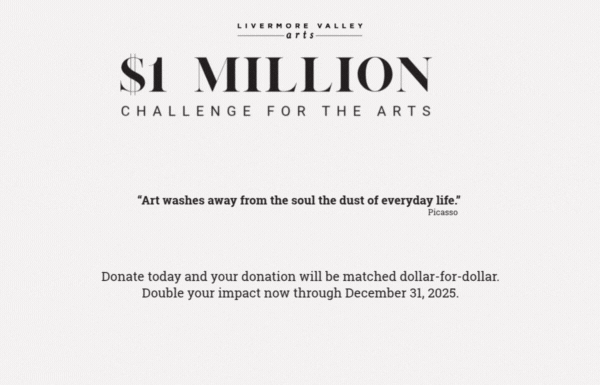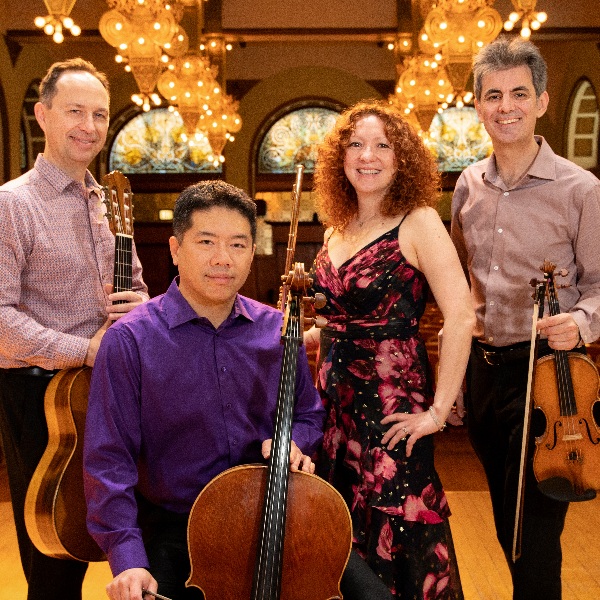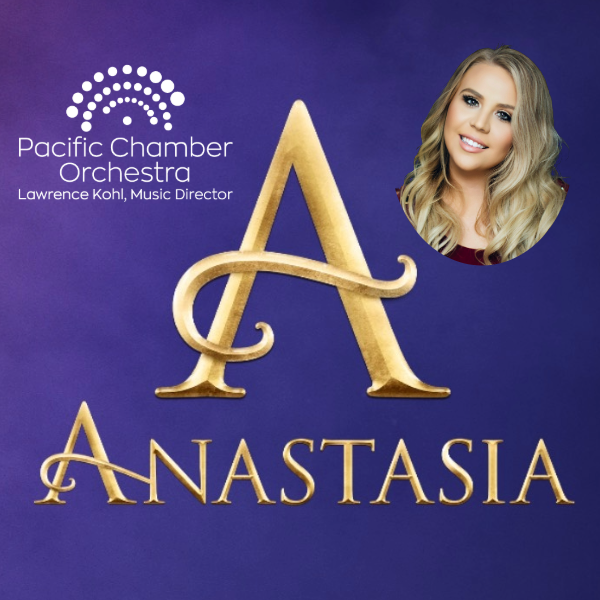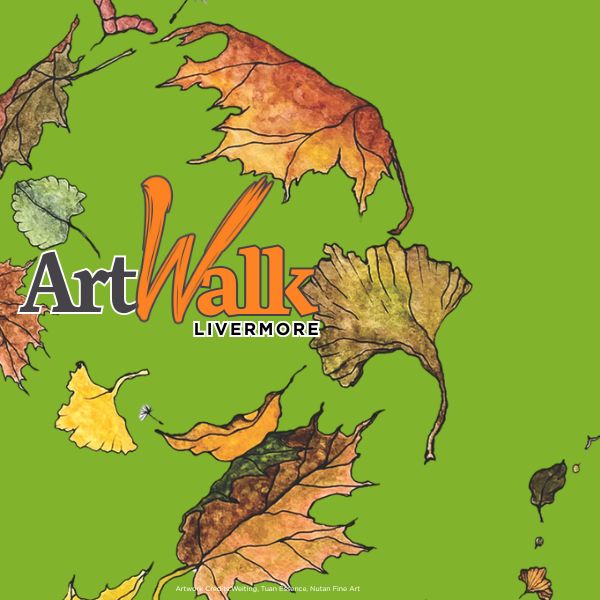Chris Carter: Hello, everybody. This is Chris Carter from The Bankhead Theater and I’m here today with Carlos Moreno from Ballet Folklorico Mexicano de Carlos Moreno. The dance company will be here on October 30th at 3 p.m. for a Dìa de Los Muertos performance, and you can go online and find tickets for that show. Those are selling fast. It’s at LivermoreArts.org.
We’re doing a series of interviews with the performers that are coming to The Bankhead Theater for our Bankhead Presents season our 22-23 season and we’re so happy to have Carlos here.
Carlos Moreno: Sí. Buenas tardes a todos. Soy Carlos Moreno de Ballet Folklorico Mexicano y quiero invitarnos a nuestra producción de Día de Muertos en el Bankhead Theater en Livermore el día Treinta de Octubre. A favor de estar con nosotros para celebrar lo bonito que es–esta celebración de Día de Muertos.
English Translation: Yes. Good Afternoon everyone. I’m Carlos Moreno from Ballet Folkloric Mexicano and I want to invite you all to our production of Dìa de Los Muertos at The Bankhead Theater in Livermore on October 30th. Please be with us to celebrate how beautiful it is–this Day of the Dead celebration.
Carlos Moreno: So are you guys keeping busy?
Chris Carter: Yeah, we are. What about you? Are you getting ready? You got a lot of stuff coming up, I see.
Carlos Moreno: Yeah, yeah. No, we–all of a sudden we got busy. We came out of this pandemic and got to be raring to go.
Chris Carter: Yeah.
Carlos Moreno: Yeah. No, I mean, obviously, you know, we all have those challenges during the year that we were shut down and so forth, but it looks like everyone is kind of ready.
Chris Carter: Good. Let’s keep our fingers crossed.
Carlos Moreno: This thing about the arts. I mean, it’s challenging, you know, we do it with passion. So we find a way to keep it going.
Chris Carter: Yeah- well, Carlos, I know that your name is in the company, but it’s really your father that founded this company, is that correct?
Carlos Moreno: That is correct. Actually, back in 1967, we’re celebrating our 55th anniversary.
Chris Carter: 55 years.
Carlos Moreno: Yeah. And you know what we’re really excited about going to The Bankhead at Livermore is that the company was actually founded in Livermore. My father resided there back in the 60s and he started with a small group of about 12 teenage students. Their parents wanted them to learn about culture, and it just kind of took off from there.
Chris Carter: And the rest is history, as they say.
Carlos Moreno: The rest is history– with a little bit of work.
Chris Carter: Well, tell me a little bit more about his roots. So he’s not originally from Livermore, is that right?
Carlos Moreno: Yeah, that’s correct. He is from northern Mexico, from the state of Durango. But he grew up as a young boy with a lot of passion for music and the theater and the arts. He did a lot of that on his own. My grandparents–his parents– were farmers in a small town in Durango.
But he was just really inspired and driven by music and dancing. So he kinda, you know, was always involved in his school and doing those type of things with or without his parents’ permission, sometimes. He stayed there late when he should have been back home helping out with the work, but there he was doing the arts.
Chris Carter: And so as a parent or growing up in an arts family with this dance company always there around you, at what age were you involved? Pretty much your whole life? Did you leave and come back, what’s your history?
Carlos Moreno: Oh, no. Yeah, I was definitely involved, I think was one of those things that I didn’t know any better. I mean, it’s just around me all the time. I first–I think I first stepped onto the stage when I was about 3 years old. I know that because I have my little certificate from the Alameda County Fair.
Chris Carter: In Pleasanton.
Carlos Moreno: But yeah, it’s funny looking back. You know, growing up during the summertime, my dad would take trips to Mexico to study, to do research, and he would take us along and so we traveled throughout the country and I didn’t realize at the time that I was actually being educated, that I learned so much about the traditions of the music and the dance of Mexico. But now, obviously, in hindsight, it was like, wow. I mean, that was just so amazing that I got the opportunity to do that.
Chris Carter: Well, can you give us a little bit of a history lesson in this style of dance and where it kind of came from? And I know there’s regionally–there’s a lot of different variations, but kind of what’s kind of the traditional story of how it came to be?
Carlos Moreno: Well, the ballet Folklorico has evolved in so many different directions. The traditions of the music and dance and all this, especially in all the small towns and villages, I mean, that’s gone on for–for centuries, and it is still pretty traditional. A lot of the smaller towns still have the center square, and people congregate there, especially on Sundays. Musicians are there, and then people just start dancing in the plaza, and that’s how many of the traditional dances, you know, have been kept going from generation to generation.
And in the, you know, around the 1950s, the National Ballet Folklorico de Amalia Hernandez was founded. So that really kind of brought national and international attention to the dance form. And it’s kind of taken off since then where we have formal dance schools throughout Mexico and at this point throughout the world–and my father was one of the pioneers in starting his dance school here in California.
Chris Carter: And you have been all over the world, is that right, with your dance company?
Carlos Moreno: Our dance company has had great opportunities to travel mostly extensively in the United States and in Mexico, but we have had the opportunity to get out, we have nationally. I mean, just a couple of weeks from now, actually, I think it’s less than two weeks, we’re going to be traveling to Hawaii, and we’re going to do a couple of performances there. And next year, we have plans to head out to France, to Paris, and get some, you know, opportunity to share our culture there. So it’s very exciting. Keep us motivated.
Chris Carter: That’s great. In thinking about kind of the history of the dance company, is there any particular performance or place that you all perform that was pretty significant for you or for your father?
Carlos Moreno: I think definitely for my father and the history of the ballet, about ten years into the school, back in 1977, is when he got first international attention performing for an international variety show in Mexico called Siempre Domingo. And that was huge because, you know, anyone in the Spanish-speaking language that would watch the show every Sunday, so we got a lot of exposure, and just the opportunity to get there was amazing. And I was a young boy at the time, but I recall that.
Chris Carter: Oh, that’s a fun time.
Carlos Moreno: Yeah.
Chris Carter: Well, let’s talk about The Bankhead performance coming up a little bit. My understanding, which I asked you a little bit earlier about talking about different regions that are represented and are there–is it–can you kind of tell are there different styles within different regions?
Carlos Moreno: Yeah, absolutely. Mexico is a very large country and very diverse. And what we are presenting at The Bankhead is Day of the Dead theme presentation. And it’s in two acts, in the first half kind of delves more into the traditional history of Day of the Dead, and within that history, there are three major areas that are populated by different indigenous groups.
So we represent that in our presentation showing dances from the Huasteca Region, from Oaxaca, and from from Michoacàn. And definitely, the style of the music is different, the–you’ll see in the clothing that they wear and within this the style of dances, I think people will really be interested in. And we talk about the different aspects of the Day of the Dead and the traditions, including the use of the marigold flowers, the arches, and the altars that are created, and delve into why people color their faces as skeletons and things like that. So it’s entertaining and educating at the same time.
Chris Carter:
Did you have like multiple choreographers for the different types of the dance or is it one choreographer that’s kind of coordinating everything? Or how do you all do that behind the scenes?
Carlos Moreno: Yeah, so I am the primary choreographer, but I’m blessed that I have a lot of talent around me, including my wife Lisa, who also helps us choreograph. So we take a lot of the traditional dances, and of course, we have to adapt them for the stage. And, you know, we’re careful to try to respect the origins of the dance, but again, add elements to it to be able to tell the story and for especially people who are not from Mexico, really connect and understand the performance that we’re doing.
Chris Carter: And then does someone design all the costumes too within your troupe, or how does that work with your work?
Carlos Moreno: Again, we’re all involved; my father, who’s in his 80s now, he’s still very much motivated, involved in a lot of costume design. Through the history of the ballet my mother is actually a seamstress, and she created most of the costumes that we use. And, of course, we do have a lot of the costumes that come from Mexico that are very specific to certain regions, use a lot of embroidery, so those we bring in from Mexico.
Chris Carter: Okay, I have to tell you, I did meet your father. He came to a performance here last year.
Carlos Moreno: Yes.
Chris Carter: I think it was Nochebuena; it might have been that or maybe another one. And he introduced himself– found me and he introduced himself, and he said, we have to come perform at The Bankhead. And I think you’ve been here before.
Carlos Moreno: He is great at that.
Chris Carter: Yeah. No good for him. Yeah. Sometimes people ask me, how do we get the performers here? How do we find them? And sometimes they find us.
Carlos Moreno: And my father is amazing. You know, like I mentioned about that, that first international performance, he will find himself to the backstage at any place and mingling with all the famous artists, singers, movie stars and all that. He’s just great at that, he’s very charming and social in that way. As opposed to myself, I’m happy just kind of staying in the dance room and being creative and so forth.
Carlos Moreno: Yeah, 20 years ago, for me to be able to be talking to you on a podcast or a radio type thing would be–I would be really stressed. But I learned to do it.
Chris Carter: And you’re doing a good job, thank you. But no, you’ll have to keep going, and maybe next time you’re at a performance here, introduce yourself or anywhere you go. So I think you’ll have to follow in his footsteps and help continue to promote that. So for audiences that are not as familiar with the story of Dìa de Los Muertos and some of the tradition around that, can you give us some background?
Carlos Moreno: Sure. Absolutely. Well, Dìa de Los Muertos specifically is on the 2nd of November in Mexico is celebrated and typically celebrated in cemeteries in Mexico. But there are a few days leading up to it, such as the day before Dìa de Los Muertos is called the Dìa de Los Inocentes, The Day of the Innocents, that day usually pays tribute to children who have passed on.
Now, the Dìa de Los Muertos celebration is really, really happy celebration, a celebration, more of a memorial of people who have passed on. So people gather and they bring food and drink, music, and there’s dancing and so forth. It is believed that during this day, the spirits come out, and everyone’s able to enjoy the time together– one time out of the year. And this The Day of the Dead is really a combination of both the traditions and beliefs of the indigenous Aztec people and then also of the Spanish that brought Christianity into it, they kind of integrated their All Saints Day and the beliefs that they have and their religious images.
Chris Carter: And so it’s–I like how you say it’s uplifting, and it’s supposed to be a happy occasion, so that’s a good way to look at it.
Carlos Moreno: Yeah. It’s interesting, you find that balance of being respectful and honoring the traditions that have been passed down from generation to generation, but at the same time, it’s evolving. But the beautiful thing about it is that it really incorporates the many generations where the children and adolescents would come together with the adults, grandparents, and so forth, and learn about their ancestors and have a good time doing it.
Chris Carter: Yeah. Did you find after that movie “Coco” came out, did you feel like that it helped introduce it to a lot of people?
Carlos Moreno
Oh, absolutely. And I must say, like, I think most people I’ve talked to, they did an amazing job to really touch on a lot of the traditions of it; they’re very respectful when they created that movie. So I mean, the only thing right now kind of concerns me sometimes is a little bit of the commercialization of Dìa de Los Muertos, you know, kind of like Christmas has kind of evolved and it’s really become real commercial. So we tried to kind of keep it grounded a little bit more and hope that people could always understand and appreciate the basis and the foundation of what is Dìa de Los Muertos.
Chris Carter: Well, thank you for keeping that going. My last question I wanted to ask you was, we’ve had Ballet Folklorico performances here in the past, and they’re always so popular. It’s been around, you know, like your company has been here for 55 years. What is it about it that keeps it so popular and that keeps people coming back? And it really continues to get stronger over the years, it seems.
Carlos Moreno: Yeah. Yeah. Well, you know, a few things, and I’ve kind of, you know, I’ve been around a while, so I’ve gone through the evolution of both from the inside and the outside perception of Folklorico. I know that, you know, initially, many years ago, we really kind of struggled to take the dance form of Mexico as a respectable dance form and discipline.
I remember many years ago, people would just say, oh, yeah, you’re just, you know, you’re just the guys, you know, hopping around the hat, you know, it’s like, well, it’s a little bit more than that. But I think, you know, a part of it to besides that kind of really bringing it into a discipline. I think the big part of it, and this is what I try to tell our dancers, is you got to go out there, and you have to interact with each other. You have to have fun. At least these dances, most of them were created based on social dances and people interacting. So the interaction between the dancers, I think, is one of the key things that the audiences notice on the dancers are dancing with each other, enjoying themselves. The audience feels it keeps them wanting more.
Chris Carter: Yeah, and you have to be in really good shape to do it, I imagine.
Carlos Moreno: Yeah, yeah, yeah. I mean, one of the things about what we do here again is its Mexican folklore. And the word folklore refers to, to the people, its the traditions of the people. So unlike maybe other dance forms where there’s a specific body type or image here in our folklore, we take, you know, all ages, all body types, short, tall, or have it, because then that way it really represents the people as a mass. So going back to the original statement, some people are a little bit better shape than others. Yeah.
Chris Carter: Well, thank you for sharing that. That’s–that’s really helpful for me, and I hope as people watch this, that gets them more excited about the performance coming up. So, anything else you want to say as far as what we should be expecting on that date?
Carlos Moreno: Oh, just really come to relax and have a good time–understand that it’s an entertaining show, but at the same time, there’s a lot of information that would be, I think, very educational. And we’ve been actually doing this Dìa de Los Muertos production–relatively new for us–we started about ten years ago, and it’s just become more and more popular and people really just have a lot of positive commentary about it. So yeah, please come and enjoy the show. It’s for everyone.
Chris Carter: Great. Well, thank you so much. Once again, it’s coming up on October 30th at The Bankhead Theater in Downtown Livermore, and it’s Ballet Folklorico Mexicano de Carlos Moreno.
Carlos Moreno: Its a long one.
Chris Carter: I know, sorry I had to look down just for a second to make sure I had it right. And it’s Dìa de Los Muertos performance, and it’s going to be a wonderful night.
It’s a great stage. It’s a wonderful stage for dance, especially. So we’re so happy to have you coming, and we’re really looking forward to it. You can find tickets online at LivermoreArts.org and come and get them. It’s going to be great. They’re selling fast. So it’s going to be a wonderful evening. Thank you, Carlos.
Carlos Moreno: Thank you, Chris.
Chris Carter: Take care.
Carlos Moreno: Bye bye.
Chris Carter: Bye.





